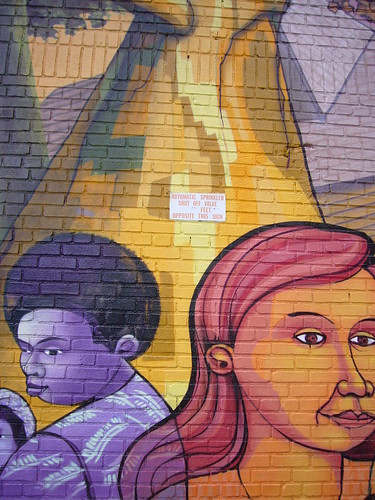
For the last couple of years, my wall calendar of choice has been the Environmental Art calendars from greenmuseum.org . Unless environmental art is your expertise, there are many relatively unknown artworks highlighted (one per month). Greenmuseum.org is also a wonderful museum site featuring the work of many. (Of note, Greenmuseum.org does indeed exist only online.)
Environmental art is more than Andy Goldsworthy, Robert Smithson, and Christo, and a lot of the work is much more complex. Some of the pieces featured in the 2010 calendar hit on an immediate and seemingly uncomplicated level: for example, Nicole Dextras' Yucca Prom Dress (2005) and Ilkka Halso's Rollercoaster (2004) (which, for the record, I find fascinating).
My favorite work in the 2010 calendar is multi-layered, ie: hits on the "immediate" level but also has numerous other concepts, statements, and implications within the work. Gilles Bruni and Marc Babarit's The Greenhouse and the Shed (2002) is March's art of choice, but I couldn't wait until March to post about it, as I sit here in January in New York and dream about springtime and walking in a green great outdoors.
I'm including the text included in the calendar; as you'll see, there's a lot of information about the art in the calendar in addition to the provocative artworks and photography. If you like to intepret art without any commentary whatsoever, stop reading now and avoid the spoilers....

The Greenhouse and the Shed
Gilles Bruni and Marc Babarit, dead Picea abies cones, boughts and branches, Corylus avellana branches, wire, stones, horticultural protective netting, Val di Sella forest, Italy, 2002.
For nearly twenty years, French artists Gilles Bruni and Marc Babarit have collaborated on experimental outdoor installations, combining agriculture, ecology, architecture and photography. A fallen Norway spruce tree on a slop of the Val di Sella forest in Italy provided them with an unexpected temporary world to explore and transform.
"We are 'sentenced' to share with the plants, the ladybug, the rat, the cloud that passes by, the night that falls, the cold, the rain," the artists say. "Thus we think that we have to find the ways toward a renegotiation of our relationships to the world, and that this renegotiation can, in particular, be done through art: we never actually work in neutral places, we have to take into account a third party with whom we must compromise."
On this Italian forest hillside, death created a space for rebirth, allowing the artists to propose a new order: "casting a net over the summit to protect the planting, protecting the cones to fertilize the compost."
Once the planting and protective structures were almost complete, "after waiting for clouds to appear, on a heavy but clear day in the valley," they took this final photograph, giving the tree another way to live on beyond the forest.




